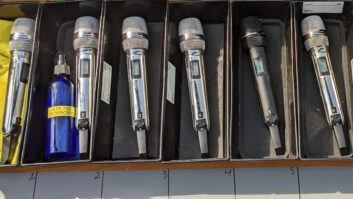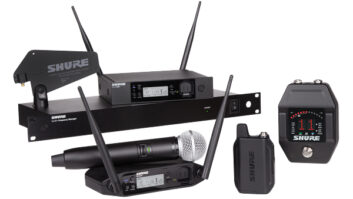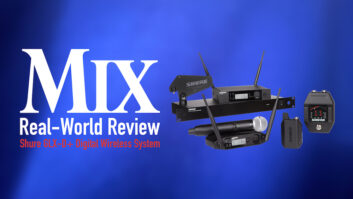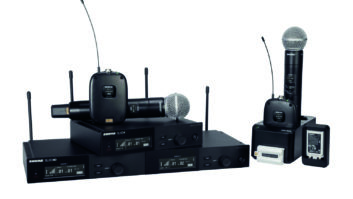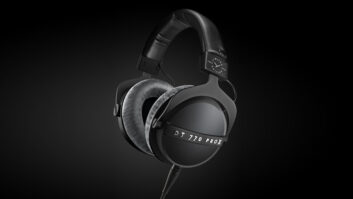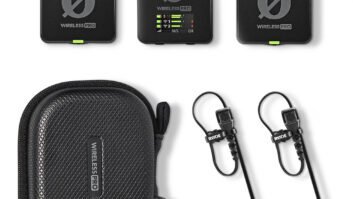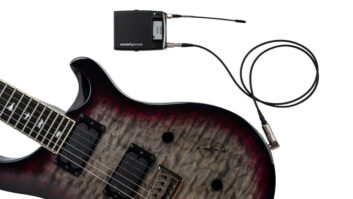The following is an expanded version of the cover story for Pro Sound News, November 2014.

On September 30, the Federal Communications Commission (FCC) released two NPRMs (Notice of Proposed Rulemaking), one proposing amendments to Part 15 of its rules, significantly affecting unlicensed wireless operations in the 600 MHz band, and a second intended to promote replacement wireless microphone spectrum access outside the 600 MHz band. The proposals eliminate the two 6 MHz TV channels currently set aside for licensed mic operators, replacing them with a 4 MHz chunk of the so-called duplex gap that is chiefly intended for ENG crew use.
“It’s encouraging that [the FCC] specifically talk about future spectrums in addition to the UHF TV bands where we may be able to operate,” says Jackie Green, Audio-Technica’s VP of R&D/engineering. “For me, that means that the FCC is trying to find solutions where wireless microphones can survive, or thrive. But I think that, in general, the mantra going forward is coexistence. We’re going to have to learn to share a lot.”
Sharing isn’t an ideal situation, says Karl Winkler, director of business development at Lectrosonics. “We can live with it, and we have lived with it a long time, but now the amount of sharing, and the types of devices sharing with us, have grown exponentially. It’s not just broadcasters and low-power TV and us, it’s any random guy with a data device in his pocket now, potentially.”
“What we’ve been trying to communicate to the FCC, and what we’ll continue to try to communicate, is that a lot of wireless microphone applications can be done in non-prime spectrum,” says Joe Ciaudelli, spectrum affairs, Sennheiser USA. “When we say wireless microphones, that includes a broad umbrella of things—ear monitors, IFB systems, intercom channels.
“But some mic applications are hyper-critical, and demand and justify clean UHF spectrum. So we support this idea of moving non-critical things outside of prime spectrum. But still, it’s important that wireless microphones have access to clean UHF.”
Licensed operators will have access to the portion of the duplex gap and will have priority, via geolocation database registration, in the shared white space spectrum. But, says Ciaudelli, “We’re concerned that the duplex gap—the special guard band between the upload block and the download block of the repurposed spectrum—is not going to be fully reliable for hyper-critical applications. Extensive tests were done in Europe in a duplex gap and the upload block and the download block spilled into the duplex gap.”
The FCC believes that what it refers to as “extensive experience” with the geolocation databases suggests that interference between white space devices and licensed wireless mic systems will not present a problem. But with no portable consumer white space devices yet on the market, and very few fixed devices in use, the jury is still out on the efficacy and reliably of those databases, say the mic manufacturers.
“I don’t think we know in the larger context whether or not they’re going to work properly, given the kind of traffic we ultimately expect,” says Winkler. “They’re saying it’s proven; we’re saying it’s not proven at all. We have no idea, when there are thousands of users in one square mile, what’s going to happen. Yes, they bumped up the frequency with which white space devices are supposed to check in to the database, which is a small step, but it’s a big interval in our world.”
Furthermore, says Winkler, no one knows what the effect will be of thousands of devices all checking in frequently with the network. “It’s scary that the interval will get shorter. More pings by more devices? We’ll see. The good news is, if they can’t check in, they can’t use that frequency.”
The characteristics of the UHF band make it especially desirable for both wireless mic and consumer device use. “The higher in frequency you go, the more RF output power is required to go the same distance,” explains Ciaudelli. “For instance, if you’re operating at 500 MHz and you want to transmit one kilometer, which is about half a mile, all you need is about 100 milliwatts. At 1.4 GHz you need about 500 milliwatts to go that same distance. Luckily, a vast majority of wireless mics don’t need to go half a mile; maybe 100 meters, or something like that. But you basically need five times the output power to go the same distance.
“That’s why UHF is the beachfront property of the RF spectrum. The wave propagation characteristics are excellent, it goes through walls and foliage, you don’t need a lot of power to go a decent distance, and you can use small antennas. So it’s really a nice balance of everything that you need for hyper-critical applications.”
But with the 700 MHz band already off limits and the 600 MHz band potentially about to become very crowded, where will wireless mic users likely be operating in this future RF landscape? The FCC’s NPRM throws out numerous possibilities for consideration, from existing licensed broadcast spectrum starting at 26 MHz to the 2.4 GHz and 5 GHz Wi-Fi bands and up through 10 GHz. The NPRM asks if technology deployed over the past several decades, including the 802.11, DECT and LTE standards, might be suitable for wireless mic transmission in the future.
The proposals and requests for more information in the NPRM promoting wireless mic spectrum access all stem from talks between the FCC and the wireless mic industry, says Mark Brunner, Shure’s senior director of global brand management. “Each of the considerations are topics that have been exchanges between the commission and the industry previously. So that’s a reflection of months and years of dialog on alternatives, all in one place. That’s nice to see, and clearly they’re trying to look at the suite of options, and have heard us.”
But while these new NPRMs offer some clarity regarding the FCC’s intentions, the commission’s position has evolved over time. “Where I think the wireless mic community needs to now respond to this notice is in some of the modifications to the TV band device rules that were created in the white space order that were done with a fair amount of study, research and years of dialog,” says Brunner. “We want to make sure that we are in a position to provide counterpoint to some of the proposals on items that were discussed at length back in the last decade.”
With future wireless mic spectrum yet to be determined, everything is on the table for consideration regarding new RF products, according to Brunner. “We’re focusing on all options; we have to. Certain bands are more suitable for certain kinds of applications and market segments. Being a global provider we have to look at how these things line up internationally, and how they line up by application and by use. It’s important for us to remain engaged on any available spectrum, because it may be useful to our customers for a certain purpose.”
“It’s in everyone’s interest—the FCC’s, ours, the telecom’s—to have a smooth transition,” says Ciaudelli. “But a precursor to a smooth transition is a clear end goal, and until we know what ranges are going to be open to us and the particular specs or regulations that we have to adhere to within those ranges, we can’t go into full production. We’ve already done the pencil sketches on the napkins and have some ideas, but until a product is fully defined on the engineering level you cannot go into production. And that scale-up is not trivial.”
Some manufacturers have been working on alternate technologies since before the transition to digital television broadcast in the U.S. and the subsequent squeezing of wireless mic users out of the 700 MHz band. “We have products out there in the market, on purpose, that aren’t working in the UHF TV band,” says Green. “All of us are trying to stick to as much UHF as we can, but there’s going to be a lot of innovation, technical solutions, product solutions.”
Innovation in wireless mic technology—which the FCC has been hoping to promote—will help overcome some of the technical challenges of operating outside the desirable UHF bands. With Audio-Technica’s Ultra Wide Band system, for example, “I can cover the same space as we are with our UHF system, and my power level is significantly, significantly less than the current UHF system,” says Green. “So there are other tricks; you have to do things differently.”
But purchasing new technology in order to operate in a different frequency spectrum once again puts the burden on users, many of whom were forced to buy new gear or pay to retune existing systems several years ago as a result of the FCC’s 700 MHz band plan. “Sennheiser submitted a formal request that the FCC use its authority, as they have done in other auctions not involving wireless mics, to compel the auction winners to compensate the incumbents for moving out of the spectrum,” reports Ciaudelli. “Unfortunately, they have denied this request. But we did file an appeal, called a Petition for Reconsideration. We feel it is absolutely unfair to repeatedly single out wireless mics to basically fund the repurposing of spectrum. It equates to a subsidy to the auction winners.”
As the new band plan continues to evolve, says Winkler, “Get your license. You have to get one, and then you have to register in the database.” Those who don’t qualify for a license may also use the databases, but are given lower priority, he adds.
“There’s not currently an accurate view of what the database is really going to have to handle,” adds Green. In fact, the databases have been so underused by wireless mic operators that the FCC commented in these latest proposals on what it considered to be “abuse” of the system by one of the major TV networks, which has been scrupulously registering its events.
“[The FCC] does need to have an accurate view,” says Green. “And they really are struggling; it’s very hard to make a decision if you don’t have data.”
Happily, she continues, awareness of the situation is increasing in the industry. “Wireless coordinators are actually applying for licenses, and have gotten them, so that’s good. And in the last two years there has been a much more concerted effort—I know, because we get these calls—to say, ‘If we wanted to make sure that everything worked, what would we do?’ So there’s a little bit more cooperation than before.
“People have to coordinate and get along, whether that’s frequency coordination or time coordination,” utilizing the same frequencies but at different times during an event or production, she says. “There’s actually a lot of cooperation amongst the industry people to be able to pull off what we’re able to do now. At least we’ve developed a habit of communicating.”
